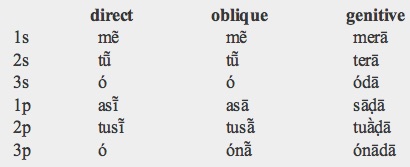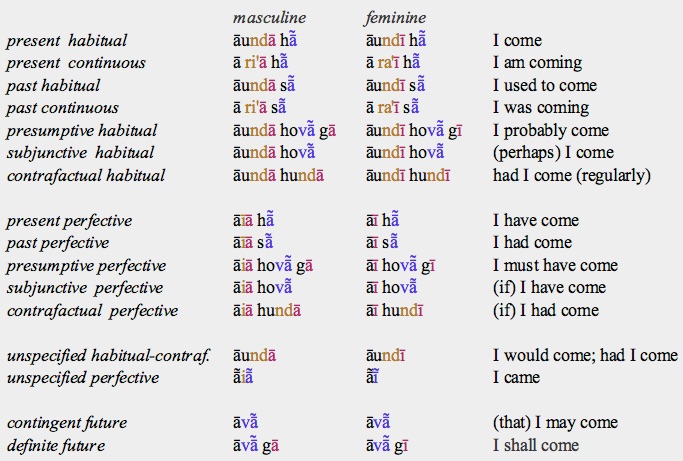An insatiable appetite for ancient and modern tongues


Alternative Name: Panjabi.
Name Origin: Punjabi means 'belonging to the [land of the] five rivers', in reference to the major affluents of the river Indus.
Classification: Indo-European, Indo-Iranian, Modern Indo-Aryan, North-Western. Other languages of the same group are Sindhi and Kashmiri.
Overview. Punjabi is a regional language of Pakistan and northwestern India. It stemmed from the medieval Prakrit language Shauraseni, at the dawn of the second millennium CE. Its territory is the Panjab, a region of alluvial plains irrigated by the five great tributaries of the Indus River. The Panjab was open to many invaders and with time became a land of religious diversity, being inhabited by Hindus, Muslims and Sikhs. With the independence and separation of India and Pakistan, the Panjab was divided between the two countries and a mass migration followed which ended in tragedy. Today, with more than one-hundred million speakers, Punjabi is among the ten largest languages of the world.
Distribution: The vast majority of Punjabi speakers reside in Pakistan (Punjab, Sindh) and India (Punjab, Rajasthan, Haryana, Delhi, Uttar Pradesh). There is a Punjabi diaspora in the United Kingdom, Canada, Malaysia, Indonesia, United Arab Emirates, Kenya, South Africa and Fiji.
Speakers. Excluding the related languages Saraiki, Hindoko and Potohari, there are approximately 115 million Punjabi speakers. Their number in Pakistan varies widely according to different sources. The disagreement arises from the status of Saraiki, Hindoko and Potohari which for some are dialects of Punjabi and for others are separate languages. Together, these four languages are spoken by about 60 % of the people of Pakistan, totaling around 110 million. Punjabi proper is spoken by three-quarters of this number (82 million) to which 33 million speakers living in India should be added.
Status. In India, Punjabi is the official language of the state of Punjab and one of the 23 official languages of the country. In Pakistan, it has no official status.
Varieties. Majhi (districts of Amritsar and Gurdaspur in the Indian Punjab) is considered the standard. There are three major eastern dialects: Doabi, Powadi and Malwi. The "western dialects" Saraiki, Hindoko and Potohari tend to be considered now as separate languages.
Oldest Documents
-
•There are early literary texts from the 11th century that resemble Punjabi with, however, some morphological differences. They are attributed to several gurus of the Nath Śaiva sect.
-
•In the 12th century, a famous Sufi preacher called Fariduddin Ganjshakar composed poems in Punjabi.
-
•Guru Nanak, the founder of Sikhism, composed hymns in Punjabi in the 15th century, later included in the Ādi Granth.
Phonology
Vowels (10). Punjabi has a ten vowel system composed of three lax and seven tense vowels. Lax vowels (ɪ, ʊ, ə) are phonetically short and tense vowels (i, e, ɛ, u, a, o, ɔ) are phonetically long. [ɪ] is slightly lower and more centralized than [i], [ʊ] is slightly lower and more centralized than [u]. Vowels may be oral or nasal and nasalization is phonemic.

Consonants (28). Punjabi has 28 consonants in total, including 15 stops and affricates, 2 fricatives, 5 nasals, 4 liquids and 2 glides. The stops and nasals are articulated at five different places being classified as: labial, dental, retroflex, palatal and velar. The palatal stops are, in fact, affricates.
Punjabi has lost the aspirated voiced stops existent in most Indo-Aryan languages leading to a three-way contrast (aspirated and unaspirated voiceless stops + unaspirated voiced stops) instead of the four-way contrast characteristic of Indo-Aryan languages (aspirated and unaspirated voiceless stops + aspirated and unaspirated voiced stops).
It has retroflex consonants (articulated immediately behind the alveolar crest) that are not from Indo-European origin though present already in Sanskrit. They are, probably, the result of Dravidian language influence. Punjabi has, also, two retroflex liquids not inherited from Sanskrit. The glottal fricative [ɦ] appears only in initial position; [ʋ] is realized as v or w.
Gemination is frequent. Sounds between brackets are found in certain dialects and loanwords.

Tones. Punjabi is the only Indo-Aryan language that has developed tones. It has three, low, mid, and high. Though they are phonemic, tones have not special signs in any of the three scripts used to write the language; they are marked, instead, by h or signs for voiced aspirated stops/affricates, otherwise unnecessary in Punjabi (see script below). In grammars and dictionaries low tone is represented by a grave accent and high tone by an acute accent (mid tone is never represented) e.g. ca (‘fervour’), cá (‘tea’), cà (‘peep’).
Script and Orthography
The religious divide between Punjabi speakers is reflected in the existence of three different writing systems. Sikhs prefer the Gurmukhī script, Hindus tend to use Devanāgarī and Muslims a Perso-Arabic alphabet called Shahmukhī. The Gurmukhī alphabet derives ultimately from the Śāradā script of northwest India, and particularly from a popular variant of it, the Laṇḍā script, employed by the merchants of Punjab. It was normalized in the 16th century by Guru Angad, the second religious leader of the Sikhs (between 1539-52).
Gurmukhī does not have any special sign to mark tones, instead the symbols for voiced aspirated consonants (which do not exist in Punjabi) or h are used: if a voiced aspirate or h precedes a vowel this acquires a low tone while the aspirate becomes devoiced (ghoṛā is pronounced kòṛa:); if the same signs follow a vowel this acquires a high tone (cah is pronounced cá); the neutral tone is unmarked.
The Gurmukhī alphabet has 35 letters ordered according to phonetics arranged in seven rows of five letters each. The first row includes three basic vowel forms, which combined with diacritics produce all the initial vowel signs required, and the two fricatives (signs for internal vowels are diacritics attached to the consonants). After them come the stops and nasal consonants divided into five groups according to their place of articulation (from back to front). The seventh row includes the semivowels (liquids and glides) also arranged according to their place of articulation. An additional row includes letters of the alphabet modified with a dot to represent foreign sounds.
Below each letter the standard transliteration is shown followed by its International Phonetic Alphabet (IPA) equivalent between brackets.



























The accepted transliteration into the Latin alphabet is as follows:
-
•the vowel [ə] is rendered as a; [a] as ā; [ɛ] as ai; [ɔ] as au.
-
•the aspirated stops and affricates are rendered as digraphs (pʰ = ph, dʰ = dh, etc).
-
•the retroflex stops [ʈ], [ɖ] are transliterated ṭ , ḍ.
-
•the affricates [tʃ], [dʒ] are transliterated c and j, respectively.
-
•the voiced glottal fricative [ɦ] is transliterated h.
-
•the nasals [ɳ], [ɲ] and [ŋ] are rendered ṇ, ñ, and ṅ, respectively.
-
•the retroflex liquid [ɽ] is transliterated ṛ. For [ɭ], the other retroflex liquid, a special sign not usually included in the alphabet is used, it is transliterated ḷ.
-
•the glide [ʋ] is transliterated v.
Morphology
-
Nominal. Nouns and some adjectives are inflected for case, gender and number.
-
•gender: masculine, feminine.
-
•number: singular, plural.
-
•case: direct, oblique, vocative.

-
The direct case is used for subject and direct object.
-
The oblique case is used for nouns accompanied by postpositions (similar to English prepositions but placed after the noun) which serve as markers for other syntactical functions.
-
Masculine nouns have two declension types, one ending in ā and the other in another letter. Feminine nouns have just one declension type.

-
Some adjectives (masculine ended in ā, feminine ended in ī) are inflected while others are not, as shown in the table:
-
Inflected adjectives agree with their noun in case, gender and number.
-
•pronouns: personal, demonstrative, interrogative, relative, indefinite.

-
Personal pronouns do not distinguish gender but are inflected for number and case, in fact, they have an additional case (genitive). Punjabi does not have a specific pronoun for the third person, the remote demonstrative pronoun is used, instead.
-
Demonstrative pronouns are of two kinds: proximal (é) and remote (ó).
-
There are two interrogative pronouns: kõ ('who?'), kī ('what?').
-
•compounds: the formation of nominal and verbal compounds is an essential and productive feature of the language.
-
Verbal
-
•person and number: 1s, 2s, 3s; 1p, 2p, 3p.
-
•aspect: imperfective (including habitual and continuous actions) and perfective (completed activities). The habitual marker is -nd-, the continuous one is the auxiliary ri'/ra' and the perfective marker is the affix -i-.
-
•mood: indicative, presumptive, subjunctive, contrafactual, imperative. The presumptive, subjunctive and contrafactual are an integral part of the tense system. Only the imperative is considered an independent mood.
-
•tense: most finite-verbs combine aspect and tense by using the auxiliary ‘to be’ plus a non-finite form of the lexical verb. There are two aspects, imperfective and perfective, and five different forms of the verb ‘to be’: present, past, presumptive, subjunctive and contrafactual (conditional). Combined together, they produce twelve aspectual tenses (the imperfective aspect has habitual and continuous forms in the present and past).
-
The present, past and subjunctive copula indicates person and number; the presumptive copula indicates person, number and gender; the contrafactual copula behaves like an adjective marking gender and number, but not person. Aspect and gender are indicated by the non-finite form of the main verb (in some tenses gender marking is redundant).
-
Besides these compound tenses, Punjabi has two non-tense forms (unspecified habitual-contrafactual, unspecified perfective), and two non-aspectual forms (contingent future, definite future).
-
For example, the list of Punjabi finite forms of the verb āuṇā ('to come') in the 1st person singular are:

-
stems: āu-, āv-, ā-
-
black: verb root; brown: aspect marker; red: gender marker; blue: personal endings.
-
The perfective marker (-i) in feminine forms is assimilated to the gender marker.
-
•voice: active, passive.
-
•non-finite forms: infinitive, present participle, past participle, agentive participle.
-
The infinitive is treated as a noun, being inflected for case; the direct infinitive is formed by adding -ṇā to the root, the oblique by adding -(a)ṇ. The present participle expresses an ongoing action, the past participle a completed action, the agentive participle an habitual or potential action.
-
•derived conjugation: causative.
Syntax
Punjabi is a Subject-Object-Verb language with a quite rigid word order. It is head-final in most sentences. Attributive adjectives precede nouns. However, when used predicatively they are placed before the verb. Indirect object precedes direct object. Syntactical relations are conveyed mainly by postpositions. Transitive verbs conjugated in any of the perfective tenses agree with their object while the subject adopts the oblique case, a phenomenon known as split ergativity.
Lexicon
Punjabi borrowings are from Sanskrit and Hindi-Urdu, Persian, Arabic and English.
Basic Vocabulary
one: ikk
two: do
three: tinn
four: cār
five: pãj
six: che
seven: satt
eight: aṭṭh
nine: nau
ten: das
hundred: sau
father: piu
mother: mā̃/mā̃u
brother: bh(a)rā
son: putt
daughter: dhī/dhīā
head: sir
eye: akkh
foot: carana
heart: hīā̃
tongue: jībh
Key Literary Works (forthcoming).
-
© 2013 Alejandro Gutman and Beatriz Avanzati
Further Reading
-
-'Panjabi'. C. Shackle. In The Indo-Aryan Languages, 637-682. G. Cardona & D. Jain (eds). Routledge (2007).
-
-Punjabi: A Cognitive-Descriptive Grammar. T. K. Bhatia. Routledge (1993).
-
-A Reference Grammar of Panjabi. H. S. Gill & H. Gleason. Punjabi University (1969).
-
-The Phonology and Morphology of Panjabi. A. N. Malik. Munshiram Manoharlal (1995).
Punjabi

Address comments and questions to: gutman37@yahoo.com
MAIN LANGUAGE FAMILIES
LANGUAGE AREAS
Languages of Ethiopia & Eritrea
LANGUAGES by COUNTRY
LANGUAGE MAPS
-
• America
-
• Asia
-
Countries & Regions
-
-
Families
-
• Europe
-
• Oceania
